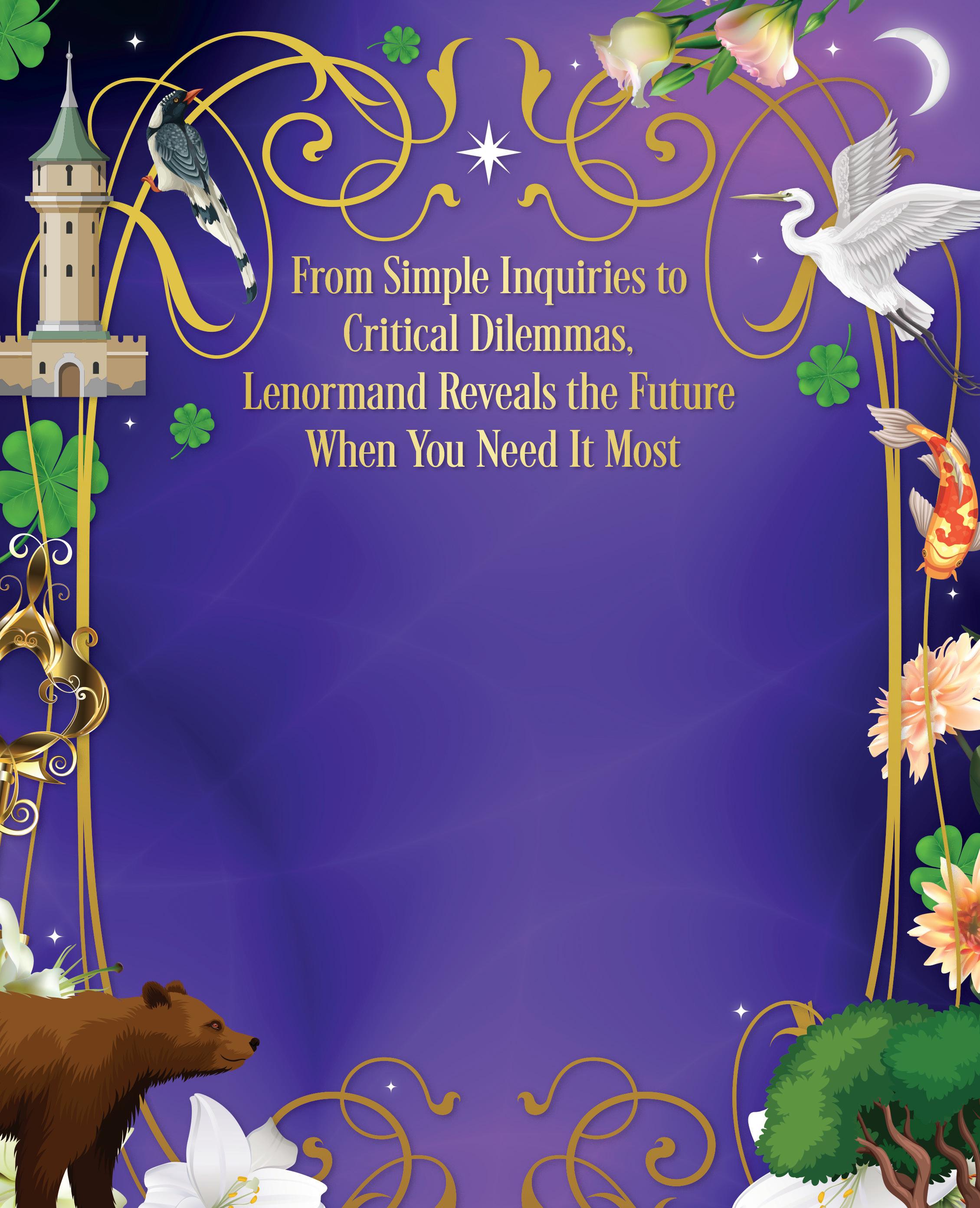
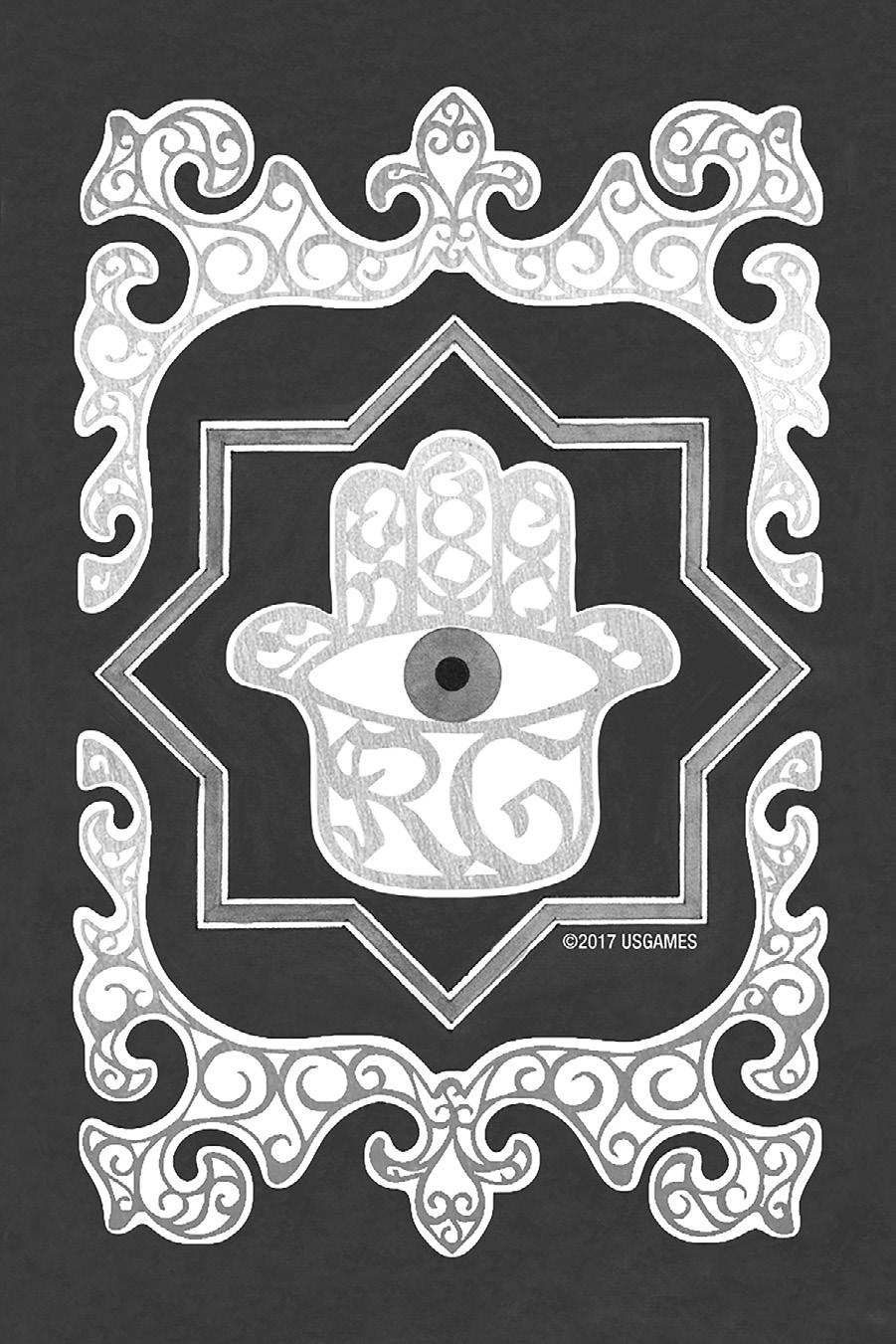



Rana George was born in Beirut, Lebanon. For over two centuries, the maternal side of her family has had an unbroken line of powerful and well-known psychics, seers, and mediums. Her spiritual quest has led her to many teachers who have helped her hone and nurture her clairvoyant (seeing), clairaudient (hearing), clairsentient (feeling), and claircognizant (intuition) talents.
Rana’s Lenormand journey spans four decades. From an early age, she showed signs of clairaudience and clairvoyance and began using her inherent abilities and a pack of Lenormand cards to give readings to friends, family, and neighbors. The little oracle of thirty-six cards was one of only five items she brought with her when her family was forced to flee the tragedy of civil war and immigrate to America in early 1988.
With her mother’s guidance and the loving help of her family, Rana has worked as a psychic, a medium, a teacher, a mentor, a fortuneteller, and a card reader, giving counsel to clients for a span of over forty years. She has been consulted on the design of several Lenormand decks and has published many articles on cartomancy. Rana’s lifelong vocation is to inspire, guide, and help by putting the cards in people’s hands and helping them find the power to shuffle them well and deal them wisely.
A respected presence in the modern divination community who has been featured in Forbes, Rana has led multiple Lenormand workshops, lectures, and study groups at many acclaimed conferences across the world, including the USA, Canada, China, Egypt, and Lebanon, and she has been a main presenter at multiple tarot conferences. Rana’s work has been translated into Chinese (both simplified and traditional), Japanese, Russian, Portuguese, and Polish. She is also the creator of the award-winning Rana George Lenormand deck published by U. S. Games.
For more information, visit Ranageorge.com
Youtube: Rana George
Instagram: ranageorge1
Facebook: Rana George
Your Guide to Precise & Practical Fortunetelling
Second Edition

The Essential Lenormand: Your Guide to Precise & Practical Fortunetelling Copyright © 2014, 2025 by Rana George. All rights reserved. No part of this book may be used or reproduced in any manner whatsoever, including internet usage, without written permission from Llewellyn Worldwide Ltd., except in the case of brief quotations embodied in critical articles and reviews. No part of this book may be used or reproduced in any manner for the purpose of training artificial intelligence technologies or systems.
First Printing, 2025
Book design by Rebecca Zins
Cover design by Kevin R. Brown
Rana George Lenormand cards used by permission of U. S. Games
Llewellyn Publications is a registered trademark of Llewellyn Worldwide Ltd.
Permission has been obtained for all examples and all names have been changed to protect privacy.
Library of Congress Cataloging-in-Publication Data
Names: George, Rana, author
Title: The essential Lenormand : your guide to precise & practical fortunetelling / Rana George.
Description: Second edition. | Woodbury, Minnesota : Llewellyn, [2025] |
Summary: “This comprehensive new edition of The Essential Lenormand features images from Rana George Lenormand (U.S. Games) as well as updated card meanings and new techniques for reading spreads. Renowned cartomancer Rana George also includes an in-depth analysis of her 40-card Muree system, which builds on the traditional 36 cards and fosters more clarity and precision in readings. Two new appendices addressing LGBTQ+ inclusive readings as well as sections on divination, psychology, and mediumship round out the updates. Rana provides step-by-step instructions so you can use any Lenormand deck for predictions on topics including relationships, work, finances, family, and more. From simple inquiries to critical dilemmas, the Lenormand provides a glimpse of the future when you need it most”—Provided by publisher.
Identifiers: LCCN 2025038297 (print) | LCCN 2025038298 (ebook) | ISBN 9780738780498 paperback | ISBN 9780738780542 ebook
Subjects: LCSH: Le Normand, M. A. (Marie-Anne Adélaide), 1772-1843—Miscellanea | Fortunetelling by cards
Classification: LCC BF1878.G46 2025 (print) | LCC BF1878 (ebook)
LC record available at https://lccn.loc.gov/2025038297
LC ebook record available at https://lccn.loc.gov/2025038298
Llewellyn Worldwide Ltd. does not participate in, endorse, or have any authority or responsibility concerning private business transactions between our authors and the public
All mail addressed to the author is forwarded, but the publisher cannot, unless specifically instructed by the author, give out an address or phone number.
Any internet references contained in this work are current at publication time, but the publisher cannot guarantee that a specific location will continue to be maintained. Please refer to the publisher’s website for links to authors’ websites and other sources.
Llewellyn Publications
A Division of Llewellyn Worldwide Ltd. 2143 Wooddale Drive Woodbury, MN 55125-2989
www.llewellyn.com
Printed in the United States of America
GPSR Representation: UPI-2M PLUS d.o.o., Medulic´eva 20, 10000 Zagreb, Croatia matt.parsons@upi2mbooks.hr
No man can reveal to you aught but that which already lies half-asleep in the dawning of your knowledge.
Kahlil
Gibran
To the memory of the love of my life, my champion, my hero, my husband, Shibu George. Without your unconditional support, your utmost faith in me, and your eternal love and encouragement, I wouldn’t be here. May your soul rest in peace. Words cannot describe how much I miss you. Another night, another dream, but always you!

For centuries, the study of divination was the domain of an elite rank of occultists.
Confronted with doubts and questions, the need for answers drew humanity to divination’s mysterious and fascinating world. This has been in practice from the beginning of humankind and continues to flourish today as printing, easy communication, and now social media platforms have made esoteric subjects more accessible to those with the curiosity and willingness to explore them. Divination takes many forms—from a simple coffee grounds reading to astrology to numerology to sortilege to I Ching—but cartomancy has evolved to become one of the cornerstones of modern divination.
This book examines my personal journey with the Lenormand deck, a small pack of thirtysix cards used as a divinatory tool since the late 1800s in the salons and streets of Europe. This deck has made its imprint on history and helped shape my life. Reading, divining, and working with clairvoyance and other forms of esoteric study have been in my family for generations. My family holds records dating back to the 1800s, when the occult represented a normal form of studies under religious mysticism.
This book is a how-to for an incredible tool and system that I have used for over forty years. Lenormand has been in my life and imprinted in my psyche since puberty; for as long as I can remember, I have been the fortuneteller in my neighborhood. Growing up in a nation torn by civil war was no easy feat, especially with people calling me crazy, a witch, and a bringer of bad omens. The funny thing is that those same people always came to me when they needed to know answers, and I welcomed them with an open heart and helped each one of them by using my main tool, Lenormand.
I have packed The Essential Lenormand with a list of practical methods, multiple approaches, and thorough guidance to help guide your own exploration of the Lenormand world. I will take you through traditional meanings and methods, along with many new insights and techniques acquired through my forty years of practice. Not only will you discover the individual card meanings, but you will comprehend how they intermingle and interact with each other
to produce clear answers. Of course, proficiency will be attained by repetition, time, practice, and experience. Furthermore, I am also including an in-depth analysis on the forty-symbol Muree system I created to fill in the gap of the many debates for certain card meanings. This new system is built on top of the traditional thirty-six cards, and I have discovered that it is immensely helpful in allowing the reader to get more clarity and precision from the cards.
My goal in this book is to teach and explain by using real-life cases. All the examples here come from real readings along with personal stories, although I’ve changed the names to protect my clients’ privacy. The Essential Lenormand will give you the ability to navigate Lenormand’s intricacies.
We are all born fortunetellers, whether we know it or not. We make predictions all the time, from forecasting the weather to the outcome of a game or blurting out a movie ending. We are all on an arc: some of us are born with it, some need to work at it, and others don’t even bother with it. Having strong intuition is an ability like singing or running or even talking. Some have the voice of a nightingale; others work on making their voice sound like a nightingale. It all comes down to will, intention, and the act of practicing.
Divining with cards is as old as their first printing. Cartomancy arose from the novelty of cards, and their use in fortunetelling falls under the reading of symbols. We are surrounded with symbols in our daily life. Every small icon gets identified with a product, an act, a feeling, a person, etc. Using symbols to glimpse into the future has been around since the early humans, who have gone from reading sand or the entrails of animals to tea leaves to scrying in water to reading cards. Humans instinctively read pictures and symbols; we cannot look at a picture or a symbol without complex associations and making up stories. Unconscious thoughts and feelings get triggered by a picture or a symbol. Opening our eyes to those signs exercises our ability to read them and use these connections and synchronicities to affect and change our daily decision-making.
In Lenormand, every symbol represents something—an object, a person, an idea, a function—by convention or by association. These symbols on the cards are easy to grasp and require no familiarity with esoterica. Lenormand cards function as a bridge of communication between the conscious and the unconscious, connecting the logical awareness to the part of the brain where the psychic activities take place. When we look for answers in the cards, we activate our unconscious mind. Every time we lay out a spread, the meanings shift and change layers, becoming personalized to the question.
This book unlocks and decodes the symbols of Lenormand cards, making its language accessible and easy to grasp for anyone willing to get on this adventure ride. We all have the knowledge hidden within us; The Essential Lenormand will trigger and awaken it.
Let me give you a picture. The room is dark but for the light of a few candles. Heavy velvet drapes cover the windows, and the drawing room door is locked. A clock ticks over the mantel. Two ladies sit across from each other at a table, talking in hushed tones. Between them rests a small deck of thirty-six freshly shuffled cards. One lady eyes them nervously, having just placed them back on the table. She can still feel them ruffling through her hands. The other picks them up and begins to lay them out. Four rows of eight cards are formed, with the remaining four at the bottom. “Are you sure these will work?” asks the lady across from the reading. “Oh yes!” is the reply.
This is a scene that has taken place in hundreds of reading salons and parlors in dozens of nations for over 150 years. This little pack of cards is divination. And while this deck may have started its life as a form of simple amusement, when it reached the hands of diviners and readers, its images became more meaningful. Somewhere during history it took the name of one of the most famous sibyls and fortunetellers of France, Mademoiselle Marie Anne Adelaide Lenormand, and these cards quickly spread throughout Europe, making it—along with tarot—one of the modern staples of divination. This little deck has endured to be one of the most fascinating and singular methods for divination used today.
The Lenormand card system of divination is based loosely on a cartomantic style from the late 1800s. That is why all the antique cards and some of the new ones include a playing card insert or a playing card value; you will find all the queens, kings, and jacks. The card numbers used are the sixes, sevens, eights, nines, tens, and aces. These card values are derived from an old game of cards called piquet that was played in salons across Enlightenment-era Europe. In many of her autobiographies, Mademoiselle Lenormand mentioned using the game of piquet as one of her divination tools. Piquet consists of thirty-two cards. Mademoiselle Lenormand later decided to add four more cards: the Six of Diamonds, Six of Clubs, Six of Hearts, and Six of Spades, thus creating the Lenormand deck.
The Lenormand deck is fairly small, usually the size of the cards people use to play bridge, and consists of only thirty-six cards. New systems have been created to give more tools for the reader. One of the popular systems I will explain on top of the traditional thirty-six card system is the forty-card Muree system that I created with the Rana George Lenormand. Each card has on it a single image, icon, or symbol. In readings, each symbol is completed and modified by those next to it. Combining the cards and their symbols in pairs will form a sentence or
a message, much like reading hieroglyphics in ancient times and emoji in our time. Every symbol has many layers of meanings, and the appropriate meaning will depend on the context of the question, the adjacent symbols, and the reader’s own insights and intuition at the moment of the reading. These symbols work in tandem to reveal truths, secrets, and events around us.
Let’s take a look at these two cards: Stars and Book. The Stars card has the symbol of many stars lighting up the night sky. Stars are a traditional symbol of guidance and hope. For a more in-depth discussion, look for the Stars in part 2 of this book.
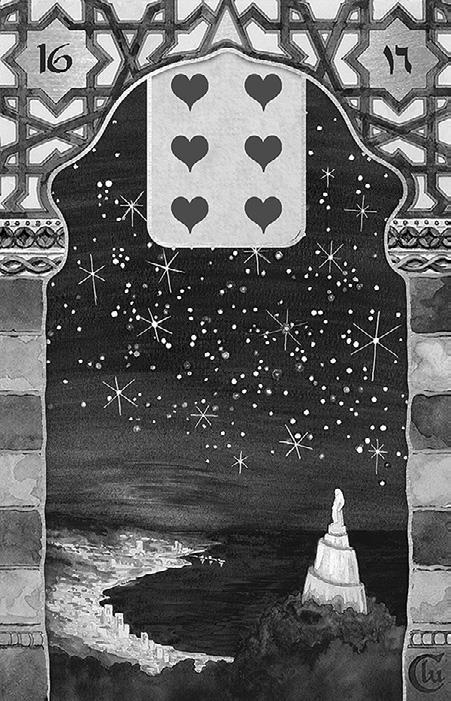
Stars Keywords
• hope
• serenity
• guidance
• spread
• popular or well-known
• a dreamer
• help from above
• connection with the universe
• success
• optimism
• recovery
• a wish
• a map
The Stars card also carries the association of the Six of Hearts. The card is number 16, which can be used for timing (sixteen days), a date (the sixteenth of a month—for example, June 16), or an amount (sixteen dollars or sixteen votes).
The Book card has the symbol of a book, a common symbol for knowledge and education. Again, you’ll find a more in-depth look at this card in part 2.
Book Keywords
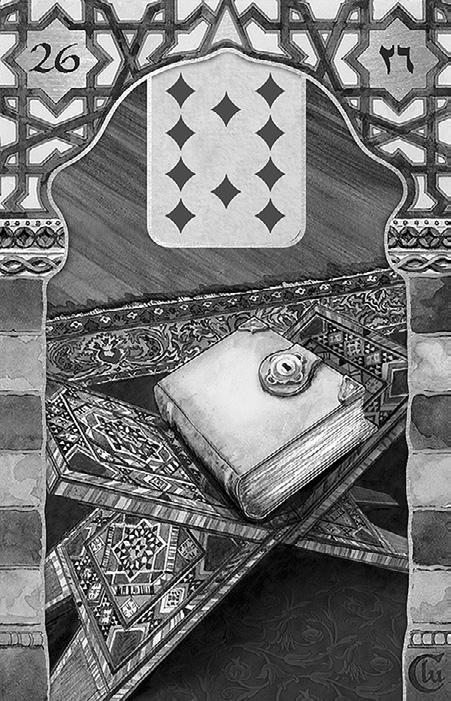
• a project
• studies
• research
• knowledge
• secrets
• hidden or unknown details
• teaching
• information
• investigation
• esoterica
The number twenty-six association with the card may be used as timing (twenty-six days), a date (the twenty-sixth of a month—for example, Clouds [6] + Book [26] = June 26), or an amount (such as twenty-six dollars or twenty-six invitations).
Now let’s put these two cards together. When doing an actual reading, the context is the key factor in choosing the correct interpretation. With that in mind, some possible interpretations of this combination include:
• a guidebook
• life coach class
• hidden map
• famous or popular book
• astrological or astronomical research
• successful studies
• Information Technology project
• manifestation journal
• secret event at night
• planner
• studying under the stars
• connecting the dots playbook
Every card resembles a word. String those cards together with other cards and it becomes a sentence. That sentence turns into a story with every additional card added. The combinations are endless. With Lenormand, using the cards should be a conversation between you and the cards.
No deck? No problem! You can turn that old pack of playing cards in your kitchen drawer into your first working deck and get started this very instant. Just take out all the twos, threes, fours, and fives and write down the name and number of every Lenormand card on its corresponding playing card (refer to the Lenormand images here; the playing card correspondence is inset in each image). I received this story from Natalie’s experience. She called me from an overseas number and told me
Lenormand was so imperative during a very hard time in my life. I was in a foreign country, and I was imprisoned falsely. While I was in prison, they gave me a juice box; after I drank it, I opened the box and tore it into thirty-six pieces and wrote down all of the Lenormand numbers. Then I shuffled them and pulled cards to see whether I was going to be able to get out and if everything was going to be okay. The cards helped me stay calm and know that I would get out soon. I proceeded to throw away all the negative cards from the little paper pieces and kept only the positive so I could manifest it, and I was out within a few days.
The fact that you don’t need special cloths, bags, smudge sticks, or other accoutrements is part of the practical nature of this deck. It is a tool you can stick in your bag or pocket and take with you to do readings whenever and wherever you need one. Another example: My friend
Roxy was at a restaurant and wanted to do a reading, but no deck was around so she tore a napkin into thirty-six pieces, wrote the card’s name on each, and threw a reading on the table right then and there. The Lenormand deck is easily accessible to all, as well as simple enough to be grasped by novices and professionals alike. Just connect the symbols and get your answer.
Lenormand is anchored in its simplicity. Several other systems of divination deal with the higher paths of life, but the Lenormand is a deck that will bring your readings down to everyday life and events. The down-and-dirty answers are ones that you can use. At first, Lenormand was not my first choice of a deck to go to for spiritual life path questions, but now I use it for anything and everything. Lenormand can give a spiritual reading that is as good as many other tools.
The most traditional Lenormand spread is the Grand Tableau, in which all thirty-six cards are used; when laid out, it uncovers a full map of a person’s situation. This is the oldest known spread and has been used by traditional diviners and readers for almost 200 years; to this day it is still one of the best techniques. We will examine the Grand Tableau in all its details in part 3.
Remember you can make a reading as simple or as complex as you like. For a quick answer, reading four cards in a linear, methodical way like a mathematical formula can produce ready results. For more subtle or complex situations, larger spreads will give better results.
Here is an example to give you a little teaser on how simply Lenormand can be read.
Question: John is a realtor who came to me worried about one of his listings. “What is going to happen with the house on the lake?”
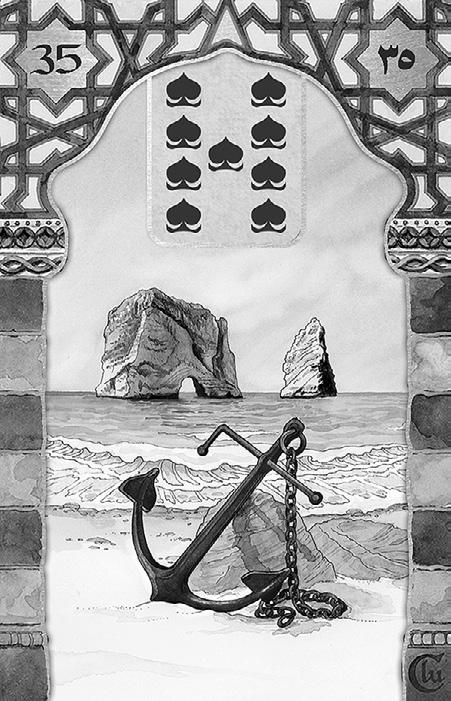
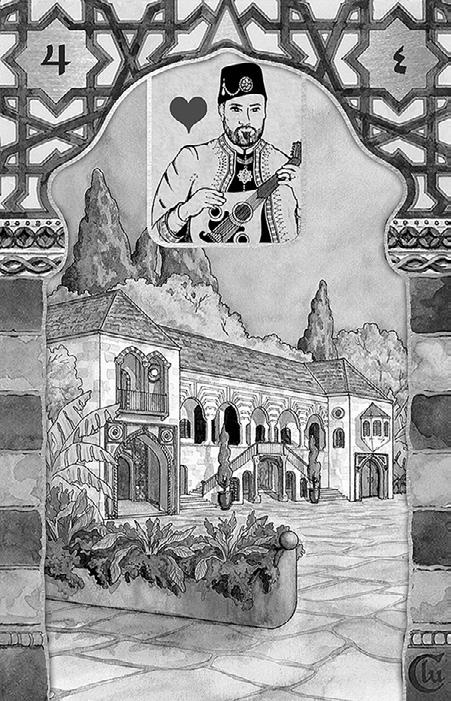

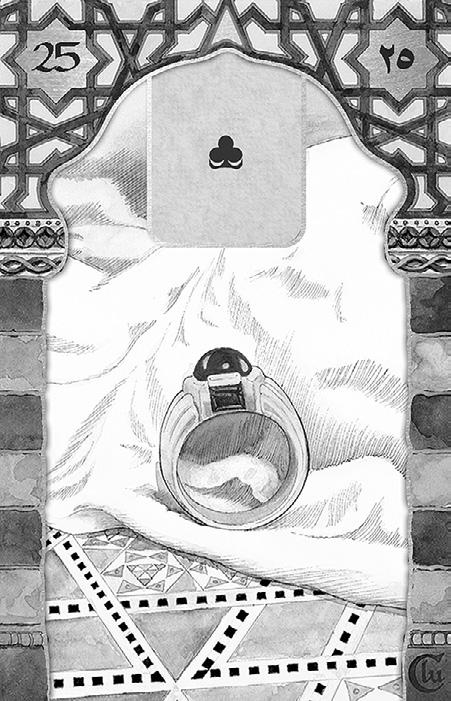
Answer: John will close the deal and the house will finally get sold. Getting the House in the spread is the cards’ own way of affirming the question, highlighting the fact that the reading is about a house, and the Anchor brings in the water feature, affirming that the prediction concerns the house on the lake. The last two cards, the Letter and the Ring, present a definite
answer for a contract and signed documents. In Lenormand the position of the cards is very important. They are linear; the last card is the final say. If the Anchor had been the last card and no Ring was present, the prediction would have changed: The house would have been stuck for a while.
Let’s look at another example reading.
Question: Jane has been seeing Jack for a month and wonders about his intentions. “Is Jack interested in a long-term relationship with Jane?”


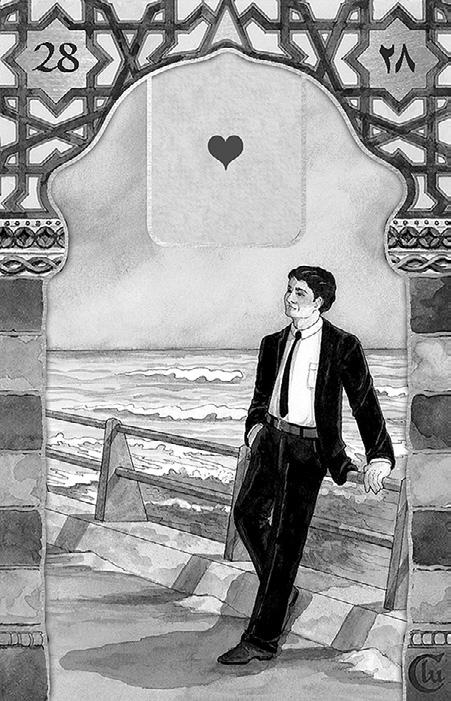


Answer: No, he is already in a committed relationship, and all he wants is another dish on the side.
The Man came up in the middle, affirming that the question is about Jack. The Ring and the Dog to his left show that he is committed to a partner already. The Crossroads and the Woman to his right show that he is double-crossing Jane. In a relationship question, the Crossroads is one of the double cards, a playing-both-fields or cheating card.
And this is what you will learn to do by practicing with Lenormand. This system’s clarity doesn’t leave room for doubt because you get verifiable answers right away.
Any tool chosen with enough practice and experience will be accurate and effective. I believe Lenormand is an exceptional predictive tool to work with. Taking the time to learn it and practice with it is the best approach to become efficient and clear in your own readings.
For me, reading a small spread of Lenormand is like reading a string of words that form a direct answer. When the Grand Tableau is laid out, it is like a book unfolding a story within a story filled with many scenarios of action, drama, and twists and turns. Lenormand is so direct that sometimes only one card is necessary to give a definitive no or yes!
The merits of reading cards are manifold; here are some that have benefited me personally:
1: Working with the cards and practicing diligently will sharpen your intuition; you will notice the symbols and signs all around you and pay more attention to your instincts. This boosts your aptitude and your figurative antennae tremendously.
2: The cards will enhance your level of confidence and self-esteem every time you help someone solve a problem or guide a soul in need. Being able to help and advise effectively will give you joy and satisfaction, as well as make you feel valuable—a priceless gift.
3: The Lenormand cards provide glimpses of the future so that you can better prepare for and manage any situation. These informed decisions can alter the future you see in the cards. I practice this with my clients by figuring out ways to change and alter undesirable outcomes. Sometimes our paths can be redirected; other times the future seems fixed. I have discovered through many years of practice that a reading often can give us the chance to change our course or show us ways to handle the inevitable.
4: The cards will act as a quick guide and counsel when you are stressed, anxious, or in need of an answer. The cards will serve as a messenger from your higher self, helping you plan as well as recommend actions. A Lenormand spread helps you understand a situation from many angles, offering counsel on your problems, past and present.
Readings alleviate fear, give hope, and occasionally satisfy curiosity. Lenormand gives powerful results proven through the deck’s longevity and ubiquity. Simply put: It works!
The Essential Lenormand begins with a basic overview of the Lenormand deck and the fundamentals that will steer you toward mastery of its system. It includes:
• a brief guide to choosing a mainstay deck for the exercises and lessons that follow
• a look at questions and how phrasing can help make your readings more powerful, practical, and predictive
• a brief testament to the virtues of picking and sticking with one Lenormand system as you begin your journey
• a guide to journaling your exercises and readings as a cartomantic foundation
• a look at the simple potency of focus cards and significators in eliciting specific answers from a spread
• a short history of my own first encounter with the Lenormand in a war-torn country
This section provides an in-depth look at Lenormand and an analysis of every card. First I will provide an overview of the Lenormand system and its origin. Then we will explore the different meanings and layers of every card in several contexts. For each card you will find:
• a description of the illustration and details
• a list of the card’s contextual meanings for several common topics: prediction, work, love, health, money, timing, advice, and specific objects/areas of inquiry
• a personal story
• how every card can be viewed in the traditional Grand Tableau and the Muree system
• the orientation of each card—whether it is positive, negative, or neutral
• the nuances of every card—whether it is an action card, a mood card, a time card, or a portrait card (all cards acquire these nuances at one time or another, but these will be their most common connotations)
• plus the four extra cards from the Muree system
There are no concrete positive and negative symbols. The relative character fluctuates depending on the surrounding cards and personal situations. A negative card can be looked at in a positive light and vice versa.
You will find that there are cards with no time reference. Timing is malleable, and not every card has a time association. Every reader will build their own timing method from trial and error. In this book I will describe the system that has worked for me in different situations.
Here we will learn how to interpret card combinations by using simple techniques and exercises to learn the cards and blend their symbols. We will tackle small spreads and move on to more intricate and elaborate layouts until we get to the Grand Tableau.
Note: Throughout this book, I will be using the terms client and querent interchangeably.
Here I will be diving into the world of mediumship, explaining what is it and how to start. I will also provide detailed steps to begin your mediumship journey with Lenormand. Lenormand can be a tool to elevate your psychic skills!
At the end of the book, we will examine the life of Mademoiselle Lenormand in a chronological format. In another appendix, I have also included an overview on how every card can be activated as a significator or a focus card, and for a quick reference, I’ve included an interpretation key; a list of the positive, negative, and neutral cards; a quick look at the house attributes; the court cards; and a method of combining Lenormand with tarot. There are also sections on Lenormand under the LGBTQ+ context as well as discovering psychology through Lenormand. Lastly, the glossary will explain unfamiliar terms and concepts.
Through The Essential Lenormand I aim to give you the full experience of all of Lenormand’s aspects, characteristics, and facets. This book will help you answer the many questions that crop up in day-to-day life and nurture a fortunetelling practice that works for you. My guidance will help you shed light on what is hidden through the beautiful and clear images of the Lenormand cards. I feel a tremendous joy and satisfaction when I see people picking up cards or any other tools of divination to benefit themselves and others. Believe in yourself and in your connection with the cards; have the confidence to predict and divine. I hope that you will enjoy playing with your deck and discovering the multiple facets of Lenormand.
Life is like a deck of cards: You have to deal with it. Relax, keep it simple, and—most importantly—have fun!
Perfection is attained by slow degrees; it requires the hand of time.

Choosing the right deck is critical at the beginning stages of learning. At the moment, a plethora of Lenormand decks are available from publishers all over the world. When you are starting to learn, I recommend picking a simple deck with basic symbols in which the artwork is very clear and uncluttered. A straightforward deck works best when learning the Grand Tableau because it minimizes distractions on the cards. Symbols should be clear and obvious during a reading. When the Lenormand symbols are cluttered and obscured with other shapes or decorations, it can interfere with your perceptions. By beginning with streamlined basics, your initial readings will flow effortlessly in an uncomplicated and direct fashion.
Only when you gain enough experience and practice will any deck be fine, as your brain will already be programmed to the Lenormand symbols. Then it will be good to let your eyes wander and your intuition soar in many directions. There are plenty of simple decks that are beautiful without seeming plain. You should connect with the deck and enjoy looking at it; the sense of enjoyment is essential in the learning process.
When reading, it is vital to approach the cards with a clear head and a specific question to get a precise answer. I carry out the shuffling process like a ritual to get in the zone and concentrate on the question. I then formulate the question in a manner that will give me a specific answer to the situation at hand. Next I decide if I will pull the cards from the deck after shuffling or shuffle and then spread out the cards and pick cards from the spread. I then determine the number and placement of the cards that I will draw. I always make sure to listen to that first instinct, that first voice I hear when I see the symbols in the cards, because nine times out of ten this is the root of my accurate predictions.
Trust yourself. Doubt is your number one enemy. It is okay to be wrong, for it only means you are taking the necessary risks on the path to proficiency. The cards alone cannot give you the answer. Your intuition and your insights are at work here; the cards are a tool or a bridge between you and the information you are seeking.
Practice makes perfect. The more you work with the cards, the greater your comfort level and accuracy will be. Make sure to do whatever is necessary to clear your head: Take a deep breath and assume a position where you feel secure, relaxed, and in control while performing the shuffling process and formulating the question.
When interpreting the cards, it is essential to keep your question in mind and answer only the question asked. Refrain from letting yourself deviate and go into a different subject. For example, if you are reading about someone’s romantic intentions, stay away from getting sidetracked by issues about their finances or their mother unless the finances or the mother relate to the romantic question. You must focus on answering the what, the who, the why, the when, the how, and the where of the question in practical, specific language. This is the only way to get precision in your reading without rambling or distraction. Keep it simple. An elaborate interpretation doesn’t ensure accuracy.
Make sure your question is properly formulated in your mind; this is the most important step in your reading. It is more important than the reading itself, and your accuracy depends on it. Formulate the question in a way that produces a clear aim and a context for useful insight. The cards can only answer the exact question you ask. If the cards don’t make sense, your focus or question may not have been clear. In that case, rethink the question and redo the reading.
The question is fifty percent of the answer. Making sure you are asking the right questions will get you the answers you are seeking. Without the right questions, it will be hard to get the right answers.
Here are some tips for crafting the right question:
• The question must be a singular question. This means it doesn’t have the word “or” in it.
• The question must be clearly phrased for the specific information you are asking. For example, if you ask “Will I be happy?” that could answer many things—happy romantically, financially, happy with your friendships, etc. The more specific the question, the better the answer. A better question to ask is “How will my happiness in this relationship be?” Ask exactly what you want to know in detail. The more detailed the question, the better.
• Avoid open-ended questions. If someone asks “Will I pass the exam?” the better question to ask is “What do I need to do in order to pass the exam?” Another example is “Should I leave this relationship?” The better way to address the situation is to ask two questions: “How will it be for me if I stay in this relationship?” and “How will it be for me if I leave this relationship?” Based on the answers, you can choose to delve deeper and ask how it will be for you emotionally, financially, etc., to leave or to stay.
• The question must be free of any negative words such as “not,” “shouldn’t,” “won’t,” “don’t,” etc.
• The question must be phrased in a positive manner. This is so that when you are given the cards for an answer, the positive cards are still positive and the negative cards are negative. If you try to start reading inversely with the cards based on the question, it is much harder and the reading will be wonky. For example, if you ask the cards “Brad doesn’t like me, right?” and you get the Coffin, then that makes it seem like the Coffin is telling you no, so then it is positive in this instance. That style of reading is a recipe for disaster. The better way to ask the question is to ask “How does Brad feel about me romantically?” Now when you read the cards you can read the meanings clearly. Another example would be if you asked “Is my job in danger?” and you got the Bouquet. Because of the question structure, this will leave you wondering if the Bouquet is saying “all is good” or “yes, the job is in danger.” Asking a question like “Is my job safe?” will lead to a clearer answer.
• Speak to the deck like you are having a conversation. One question can lead to another and another. This allows you to start with something maybe more general and then find out the specifics as you continue with the conversation. For instance, if you first ask “What do I need to do to achieve a promotion?” then you can probe further with “What does my boss think of me? What are the obstacles in the way of my promotion? How can I remove those obstacles?”
Examples:
• What are Amy’s romantic thoughts about me?
• How will I do on my test?
• How will our dog react to the new puppy?
• What is the best way to tackle this situation?
• How does our financial state look in the next three months?
• What are Alex’s intentions toward me?
• Is my job secure?
• Will I get this job?
• Will Tanya land this contract?
• How will Robert react to the news?
• What am I to expect on my trip?
• Is Jason’s relationship stable?
• What are my prospects for a love interest by the end of this year? (It is always better to specify a specific time frame for more accurate results.)
Coming up with the most direct and specific question will help you get the most clear and precise answer. Lenormand is a predictive tool. All questions are valid as long as they are simple and precise; a vague question will produce a vague answer. Be very specific in your question and you will see how the Lenormand will answer in a very direct manner.
On the other hand, when doing a general reading without a question, use the cards to determine the focus card and the issue at hand. A general rule when pulling cards for a daily reading with no question in mind is to keep the interpretation simple and grounded.
Questions dealing with time, as in “when,” are a little tricky. I have found that using the seasons for a time frame works best. Try to incorporate the time in the question, like “Will Shawn land the contract by the summer?” or “How will this situation develop during the winter?” Time is elusive; we influence time frames with our actions. The cards’ time is different from our material time; in one sense, we are trying to access wisdom that doesn’t adhere to our linear human time. What the cards will do is give us the sequence of events that can help us determine an estimation of time once we can determine the context.
I cannot stress enough the importance of these first steps: Breathe, center yourself, shuffle, think of a clear question, and then pull the cards.
At the beginning of your Lenormand journey, consistency must be your maxim. As you take the first steps, start with a set of meanings and stick to them, making them your foundation and base. This method will amplify your accuracy. For example, decide on the card you associate with finances and the card you associate with health and make sure to adhere to those symbolic associations. If you mix meanings or are indecisive, you will disrupt your unconscious, compromise the clarity of your answer, and always have the doubt of which meaning applies, which will affect your confidence. For my part, I use the Bear as the finances card and the
Tree as the health card. Eventually you will build on the traditional meanings and cultivate your own set from your own successful readings. You have to experience the cards in order to understand how they speak to you.
In the resurgence of Lenormand, I learned that different Lenormand systems exist with a slight variation to the meanings, depending on their country of origin. The array of schools can create tremendous confusion because of the debate over context and approach. However, the distinctions between them are minor and involve subtle variations in the reading of a few cards. I lean toward the French/Belgian/Dutch set of meanings. Each has value and potency, but you must stick to your set of meanings. You can always expand these associations later, but to develop a firm grip on the deck, pick one set of meanings and adhere to them. In that way you will attach those meanings to those cards within your own mind. Your intuition will flourish within the Lenormand’s symbolic structure, and your predictions will grow in precision. Every card needs a specific attribution for an accurate prediction. Being consistent is a key factor and a very important step in learning how to read Lenormand. So again, I have to emphasize the fundamental need to be consistent!
For me, the Muree system (the system that I created) has worked the best. Muree is a name that came to me as a message for a system that anyone can use freely. This system has the thirty-six cards that follow the French set of meanings, and there are four extra cards that clear up any debates on cards that have more than one meaning. The four extra cards are Spirit, Incense Burner, Bed, and Market. These four extra cards have allowed me to have more in-depth readings, accuracy, and understanding. Because these cards have specific meanings, they allow other cards from the traditional thirty-six to retain their specific meanings as well. For example, there is no definite sex card or work card in the traditional thirty-six cards. Many systems argue over which card should carry the sex meaning along with its own traditional meaning. The Muree system provides a card specially for sex and a card specially for work; that way, a reading can be more precise by freeing the Fox from the work aspect of it and freeing the Whip from the sex aspect. I will go into more in-depth analysis explaining how this system works later on in the book.
The Lenormand will work for you the way you have programmed it. This is why every reading style and every system will work as long as you stick to one system. The cards will show you what you need for the correct answer. For example, if a system uses the Moon for work, then your cards will show you the Moon for questions regarding work; for another it will show the Fox; and for me it will show the Market.
Lenormand will always show you, the reader, what will work for your own style and system. This is why it is not advisable to read and interpret someone else’s cards. Their cards will show them what they need, and that would be different for each reader.
Journaling will facilitate your personal connection with the cards and produce a perfect record to revisit as you learn. The easiest way to start is to select two cards a day and document them in your journal. Every morning, pull two cards and write down what you think they mean. At the end of the day, make a note of how those symbols manifested in your day. Since each card has a single symbol, you need two or more to produce a useful prediction. These simple daily readings will allow you to track your accuracy and reactions.
Over time, you will develop your own combination reference, and the cards will sync with your mind and intuition. When you start feeling a little bit more comfortable, move on to three cards a day, and so on. You can also use your journal for all your readings, recording your predictions so you can gauge hits and misses. Even if you only pull one card for a question or a situation, write down your question and the card pulled. This activity will improve your precision and nurture a tight rapport with your cards. Journaling is a highly important step in your learning journey toward reaching a natural flow in your predictions.
The most important part of learning is to practice, practice, and practice. It has been said that mastery of any activity requires ten thousand repetitions; the more you can read and check the outcome, the closer you can reach that kind of proficiency. Practice on yourself, on TV shows to see who is going to win or “whodunit,” on the news, on elections, on the Oscars, even on the weather. Predict, predict, predict. Predict on things that that give you a confirmation quickly. The more you use the cards, and the more you do these exercises, the faster the learning process will become. It is like working out: The more you work out, the more supple and muscular you become. The more you practice reading, the more accurate and connected you will be with your cards, intuition, and psychic abilities. And I repeat again: Remember to journal your predictions as a way of keeping yourself diligent and tracking your progress.
A significator or focus card is specifically preselected from the deck to represent a situation, an event, or a person in question. In Lenormand, the Woman and the Man cards always represent
your client, or the person getting the reading, unless they are specially picked out to represent a certain person. When a card is picked to represent other topics or subjects you are reading about, activate the specific card with concerns related to the topic. Activating/charging a card sets the intention by energizing the symbol with the question at hand and superimposing that element of the querent’s situation on the card’s timeless image. The same is true of the Man/ Woman as the client’s significator: For a female client, you need to activate the Woman card for her specifically. For a male client, you might activate the Woman as his wife, his sister, or his female boss, based on the question.
By activating a particular card for particular people, topics, or concerns, you cast that card as if it were an actor onstage so that it can play a certain role in this particular reading. For example: The Snake card may serve as a missing bracelet for one reading and a two-faced friend in another. The Ship card can represent my upcoming trip or my transition to my new life. The Book card can represent a just-finished project or a hidden secret. In your mind’s eye, see the issue at hand being overlaid by the relevant card while you are shuffling; keep on shuffling until the topic and the focus card are one. For example, if you want to read about a trip, you could activate the Ship card, shuffle the deck, then look for it in the deck and read it with the cards that it is sandwiched between. If you want to read about a project you are working on, activate the Book card. The more mindfully you activate the cards, the more specific details will emerge in all your readings.
This method is not mandatory. You can ask the question and just pull the cards without activating them, but I suggest that you try using both ways for a while and compare the outcomes.
Focusing on the topic will be sufficient in some readings, and the deck will indicate the card requiring your focus by itself. This method works better when you pull an odd number of cards; the card showing up in the middle will be the important card for you to focus on. For example, if you are focusing on your upcoming trip and the card in the middle happens to be the Bear, then the advice would be to watch your spending or be aware of where you put your wallet and purse or pay attention to meals, since the Bear is the symbol for money and diet. Basically, the cards pulled will guide you to the focus of your reading, with the surrounding cards providing the details.
That clarity is what I like about not preselecting a significator or focus card and just pulling the cards randomly. Almost always, the cards will identify the primary issue without input from the client. When reading about a business trip, the Ship card appearing on its own, without being activated, is the cards’ way of confirming your question. The reading and the reality have synchronized.
In my experience, I have found that both methods work well. I use both, allowing the cards to direct the reading and at other times selecting the main cards and reading around them.
Before I can tell you how to use the Lenormand deck my way, I would like to share my own first view of the cards. My experiences and how the deck fell into my life helped shape me as a person as well as taught me how to use them to their full potential.
I was born at a time when Beirut, Lebanon, was called the Paris of the Middle East. My family’s maternal lineage was drenched with psychics and empaths. Much later in my life, I found out that I had two great-grandfathers on my mother’s side who were very well known as mystics and psychics. Her maternal grandfather was a regular medium and a channeler, but her paternal grandfather was a pharmacist versed in the arts of everything esoteric—he was a healer, a medium, a channeler, a fortuneteller, a religious mystic, an alchemist, and much more. The local people revered him and would come to him for help; however, at the same time, they feared him. There were a few more relatives here and there that were well known for their mysticism and healings. It wasn’t long before I realized that I followed in the footsteps of my ancestors. It was a gift. As a kid, though, I had no idea how to use it, control it, or embrace it.
Growing up in Beirut, I saw the start of the civil war and endured twelve years of it. During the war there was always either someone being killed or abducted. After one of these tragedies hit home directly, my family and I escaped the country. It was a tense time. My father wanted to move to France, while my mother wanted to move to America. With much thought and consideration, the decision was made: to the great United States we went.
My story with Lenormand started when I was around ten years old and living in Beirut. Uncle Charles was a close friend and a neighbor to my parents. Beirut was his home, but he also carried a French nationality; it was the norm back then. He used to always stop by for coffee, a reading, and a chat. He was from a Lebanese-Jewish family that had been in Beirut for many generations.
I have very fond memories of him, and he played a great part in my life with Lenormand. Uncle Charles was also a psychic and a great seer in the mystical Ordre de la Rose-Croix. I recall he used to go someplace in the mountains of France where he attended psychic meetings. I would sit in the hallway when I was supposed to be sleeping and listen to the stories he told my parents of men who could move objects with their mind and other men who could make plants grow. He explained how he was able to check up remotely on his friends in France and vice versa.
Uncle Charles didn’t want to leave Beirut or his home. His love for Beirut was so strong that he endured the first four years of the civil war until one evening when, late at night, there
was knocking at our door; it was Uncle Charles with a suitcase. He had received a tip from the militia of a serious threat to his life. The situation was very dire in Beirut, with explosions and gunfire, total political unrest, and the airport closed temporarily. Uncle Charles had to hide in our home for a while; it was a time packed with esoteric teachings and readings. The moment the airport opened, my mom and dad hid Uncle Charles in the car and drove him under the cover of night to the airport, where he took the first flight out of Beirut. Before he left, Uncle Charles gave my mom a deck to pass on to me when she felt the time was right. This was my first and only Lenormand deck for most of my life. That was the last time I ever saw him. Since he fled the country, contact was hard and minimal until it was finally totally lost. I hope he knows what became of that little girl with the pack of thirty-six cards.
For the next two years, my mom used that deck, and I watched her every day. Later I started doing little readings here and there for family and friends. Eventually the circle grew and kept on growing until it encompassed the neighbors and their friends. They used to all come with chocolate, desserts, and homemade cakes. I remember one specific neighbor coming with a plate of homemade maamool (a Lebanese dessert stuffed with walnuts and dates). Her reading was a bit undesirable, but I gave her the warning about her health. The next morning at six a.m., I was running late for my school bus—and of course the electricity was out again so I had to run down five flights of stairs. By the time I reached the second floor, she had opened the door and screamed from the fourth floor: “Rana! Remember your reading last night? I fell in the tub and twisted my ankle!” All I could think to answer was “I’m sorry!” That was the first of my many “I wish I hadn’t predicted that” moments.
The rest of my teenage years were atypical. Life weighed heavy through those years. I experienced friends and family members getting tortured and shot, others getting abducted, and all the while I had to live with predicting most of these treacherous events. The last of the pain and suffering we could stand to endure before fleeing the country was the death of my grandmother and my two young aunts. These were not typical deaths; these were the most horrific and appalling murders anyone could ever bear. These events signaled the end of our life in Lebanon.
Throughout all of this, my mom was my anchor, my wall, my protector, and my hero; she was the one standing strong in front of people, defending the sanity of her daughter. With our escape to the United States, I made sure to bring with me the five items I cherished the most: my Lenormand deck, my polar bear, my only Barbie (wearing an off-white lace wedding dress), my diary, and my makeup case.
The move to the United States was no easy feat, and trying to live and fit in was just as hard. By then I was almost eighteen. I used to do readings for anyone who asked. Not only did I
read with Lenormand, I read palms as well. One day on a double date with my close friend Tina, I saw danger in the hand of my blind date. I didn’t know the guy, and I didn’t know what to say. Should I tell him or should I stay quiet? Tina suggested that I tell him, so I did, and he looked at me funny. The next day he got stabbed in an alley. I went to the hospital with Tina to visit him, and the minute I walked into the room he pointed his finger and screamed as loud as he could to “get that witch out of my room.” I was shocked, horrified, mortified, and couldn’t breathe. I went home and cried for a week. After that episode I realized that for me to fit in, I had to be very careful, so I only read for very close friends and family.
My only Lenormand deck stayed with me through all the years of college and marriage. After years of use, the deck was breaking apart in my hands; I was losing my precious deck, and I had no idea where and if I could get another one. In 2009 I decided to go on the web and do a search for “Lenormand.” Imagine my shock when I discovered I could actually buy another one. I found a plethora of information and a great community of people who shared my passion for divination. This instantly supportive tribe seemed an absolute miracle; the universe led me to a wonderful tarot community. Through it I met the most amazing people who taught me the art of tarot and much more, and in return I shared my Lenormand knowledge.
Over the past four decades, that little Lenormand deck has changed me to the core; those cards got me through the toughest times and always showed me a path. They grew up with me just as much as I grew up with them. From my early teenage years to my wife and mommy days, they have shaped my life. I have taught my three boys to do readings as well, and they do it beautifully. They solve many of their problems with just a deck of cards. Reading cards empowers people; it is a transformative tool.
On the next page is an image of a few cards from my faithful Lenormand deck, the deck that was given to me and stayed with me as my only reading deck for twenty-seven years. After doing a little research, I found out that this particular edition dates from the early 1900s. It is a simple deck and considered one of the classics: a red-tinted copy of the Dondorf design.
This deck is a part of me, and I treasure it utterly. The constant use throughout all these years has made it fragile to the point where it is literally falling apart. It is tucked away in a special box far from any hands. It is amazing how a simple, small deck of cards has made such an impact on my life since the day it came into my little hands. It is my companion, my solace, and my guide; it molded me into the woman I am now.
My personal journey with Lenormand changed my life; I hope The Essential Lenormand can do the same for you.
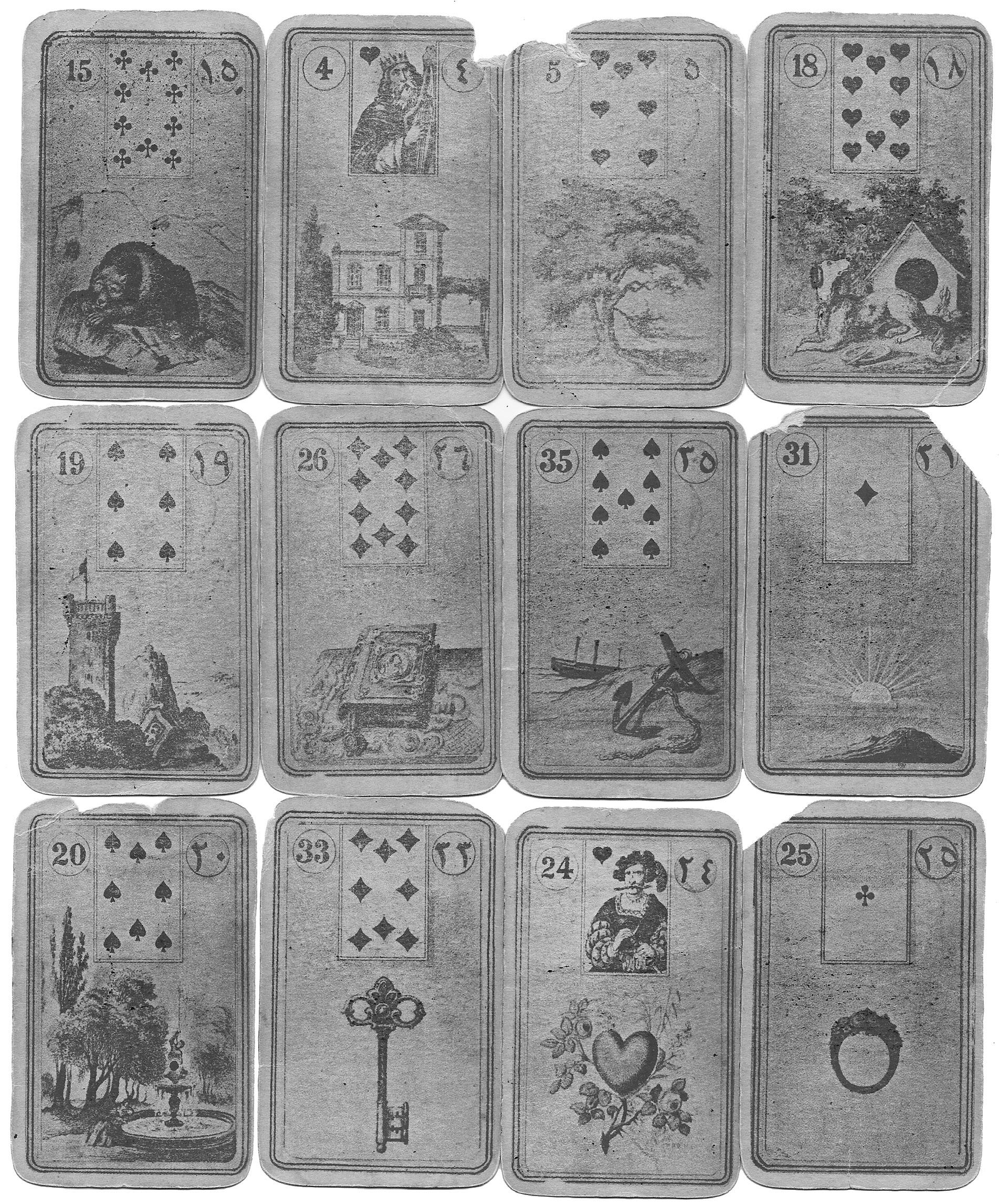
A Few Well-Loved Cards from My First Lenormand Deck

Lenormand is a 36-card deck with simple, straightforward illustrations that provide direct answers for the reader. For over 180 years, the Lenormand deck has been a popular divination tool around the world, and leading expert Rana George makes it easy to change your life through the cards.
This comprehensive new edition of The Essential Lenormand features images from Rana George Lenormand as well as updated card meanings and new techniques for reading spreads. Rana elaborates on her 40 card Muree System and includes new information on LGBTQ+ inclusive readings and sections on divination with psychology and meditation.
Providing step-by-step instructions, example spreads and readings, and ways to improve your mediumship, Rana shows how to use Lenormand for predictions on any topic. From relationships and family to work and finances, every question will be answered.
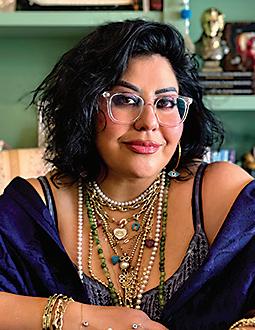
Rana George is the author of the bestselling and highly acclaimed The Essential Lenormand as well as the award-winning Lenormand deck Rana George Lenormand. A respected presence in the modern divination community and featured in Forbes magazine, Rana leads regular workshops, study groups, lectures, and intensive courses at acclaimed conferences across the world. For 40 years, Rana has been a psychic, counselor, mentor, teacher, and medium. She has done thousands of readings, consulted on the design of several Lenormand decks, and published several articles on cartomancy.
Facebook.com/LlewellynBooks
X: @LlewellynBooks
Instagram: @LlewellynBooks
www.Llewellyn.com
$29.99 US
